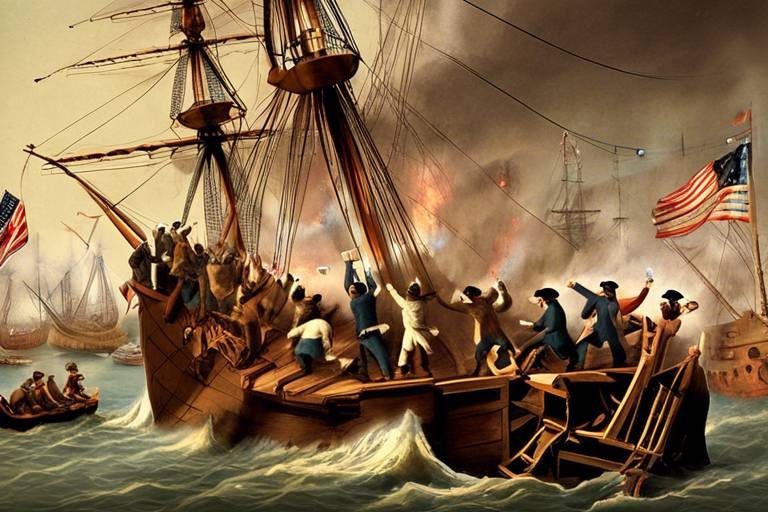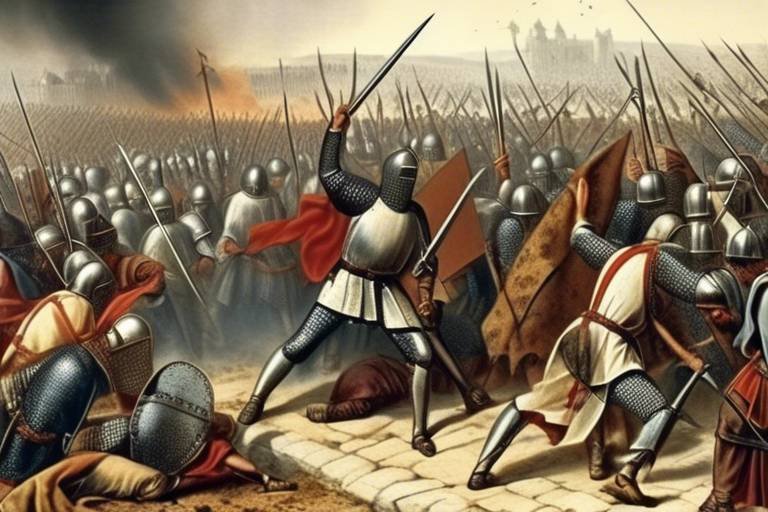The Battle of Hastings - A Turning Point in English History
The Battle of Hastings in 1066 stands as a pivotal moment in English history, forever altering the course of the nation and leaving an indelible mark on its politics, culture, and society. This historic clash between William the Conqueror and Harold Godwinson shaped the future of England for centuries to come, ushering in a new era of Norman influence and fundamentally transforming the landscape of the country.

Background of the Battle
The Battle of Hastings in 1066 was a pivotal event in English history, marking a significant turning point that shaped the future of the nation. The roots of this historic battle can be traced back to the death of King Edward the Confessor in January 1066, which triggered a succession crisis. Two prominent figures emerged as claimants to the English throne: William, Duke of Normandy, and Harold Godwinson, the powerful Earl of Wessex.
William, also known as William the Conqueror, claimed that King Edward had promised him the throne, while Harold Godwinson argued that he had been appointed as the rightful successor by the English nobles. This conflicting claim to the throne set the stage for a fierce and decisive confrontation that would alter the course of English history forever.
Harold Godwinson, upon assuming the throne, faced immediate challenges to his rule, including invasions by both William of Normandy and the Viking king Harald Hardrada of Norway. Despite successfully repelling the Viking invasion at the Battle of Stamford Bridge, Harold's forces were left weakened and exhausted, paving the way for William's invasion and the ultimate clash at Hastings.
On October 14, 1066, the forces of William the Conqueror and Harold Godwinson met on the battlefield near Hastings in a brutal and intense confrontation that would decide the fate of the English crown. The Battle of Hastings was not just a clash of armies but a clash of destinies, with the future of England hanging in the balance.

Key Players
When delving into the pivotal Battle of Hastings in 1066, it is essential to highlight the key players who shaped the course of English history through their actions and decisions. At the forefront of this historic clash were William the Conqueror and Harold Godwinson, both vying for the English throne with fervor and determination. William, known for his military prowess and ambition, sought to assert his claim to the crown, while Harold, a prominent English noble, defended his right to rule with valor and resilience.
Accompanying these central figures were a host of notable nobles and warriors on both sides, each contributing their skills and strategies to the unfolding battle. Among them were William's trusted commanders, Odo of Bayeux and William FitzOsbern, who played crucial roles in executing the Conqueror's military tactics. On the opposing side, Harold's loyal companions, including his brothers Gyrth and Leofwine, stood by his side in solidarity and loyalty, ready to defend England against the Norman invasion.
As the clash of armies commenced on the fields of Hastings, the fate of England hung in the balance, with these key players at the forefront of the unfolding drama. Their decisions, bravery, and leadership would ultimately determine the outcome of the battle and shape the future course of English history for generations to come.

Battle Strategies
When delving into the Battle of Hastings, one cannot overlook the intricate battle strategies employed by the key players, William the Conqueror and Harold Godwinson. The clash of these formidable forces marked a pivotal moment in English history, shaping the destiny of the nation.
William the Conqueror, known for his innovative military tactics, utilized a combination of cavalry, archers, and infantry to outmaneuver his opponent. The Norman army's cavalry charges were particularly effective in disrupting the English shield wall formation, allowing for strategic advances.
On the other side, Harold Godwinson relied heavily on his infantry forces, bolstered by the famous English longbowmen. The shield wall formation, a hallmark of Anglo-Saxon warfare, provided a solid defense against the Norman onslaught but ultimately proved vulnerable to the cavalry assaults.
The terrain of the battlefield also played a crucial role in shaping the battle strategies. The steep slope of Senlac Hill, where the conflict took place, offered advantages and challenges to both sides. William strategically positioned his forces to exploit the terrain, while Harold sought to defend his position against the Norman encroachment.
Throughout the day-long battle, both commanders displayed resilience and adaptability in response to the changing tides of war. The ebb and flow of the conflict tested the mettle of the soldiers and the leadership of their generals, culminating in a decisive turning point that would reverberate through the annals of history.

Outcome and Impact
After a grueling day of battle on October 14, 1066, the Battle of Hastings came to a decisive end with the Norman forces emerging victorious over the English. This monumental clash between William the Conqueror and Harold Godwinson marked a significant turning point in English history, altering the course of the nation in profound ways.
The immediate impact of the Battle of Hastings was felt across English society and governance. With the death of Harold on the battlefield, William the Conqueror solidified his claim to the English throne, ushering in a new era of Norman rule. This shift in power led to widespread changes in landownership as William redistributed land among his loyal followers, cementing their allegiance to the crown.
Moreover, the Battle of Hastings introduced Norman influence into English culture, language, and architecture. The Normans brought with them a distinct feudal system, reshaping the social structure of England and establishing a hierarchical society based on loyalty and land ownership. This transformation laid the foundation for centuries of feudalism in England.
The legacy of the Battle of Hastings extended far beyond the battlefield, leaving an indelible mark on English identity and national consciousness. The Norman conquest not only shaped the development of English law and government but also influenced the evolution of English language and literature. The fusion of Norman and Anglo-Saxon cultures gave rise to a vibrant medieval society that laid the groundwork for the English Renaissance.

Legacy of the Battle
The legacy of the Battle of Hastings looms large over English history, leaving an indelible mark on the nation's identity and development. This pivotal event, where William the Conqueror emerged victorious over Harold Godwinson in 1066, ushered in a new era for England, profoundly shaping its culture, language, and societal structure for centuries to come.
One of the most enduring legacies of the Battle of Hastings is the introduction of Norman influence to England. Following his victory, William the Conqueror implemented a system of governance that blended Norman traditions with existing English customs. This fusion of cultures laid the foundation for the development of a distinct Anglo-Norman identity, influencing everything from architecture to governance.
Furthermore, the Battle of Hastings played a crucial role in the establishment of feudalism in England. William the Conqueror redistributed land among his loyal supporters, creating a system of landownership that tied individuals to the crown in exchange for military service. This feudal system not only solidified William's control over England but also shaped the social hierarchy and power dynamics of the nation.
In addition to its immediate impact, the Battle of Hastings left a lasting imprint on the English language. The Norman conquest introduced a plethora of French vocabulary into the English lexicon, enriching the language with new words and expressions. This linguistic fusion reflected the cultural amalgamation brought about by the conquest, highlighting the enduring influence of the Battle of Hastings on English communication.
Architecturally, the legacy of the Battle of Hastings can be seen in the construction of iconic landmarks such as the Tower of London and Westminster Abbey. These structures, built in the Norman architectural style, stand as tangible reminders of the conquest's impact on English building practices and design aesthetics. The fusion of Norman and English architectural traditions gave rise to a unique architectural heritage that continues to define England's built environment.
Moreover, the Battle of Hastings catalyzed a period of cultural exchange and artistic flourishing in England. The blending of Norman and English artistic traditions resulted in the emergence of a vibrant artistic scene that produced exquisite manuscripts, intricate tapestries, and ornate metalwork. This cultural renaissance, fueled by the convergence of diverse artistic influences, enriched English artistic expression and set the stage for future creative endeavors.

Historiography and Interpretations
When delving into the historical accounts of the Battle of Hastings, one is met with a plethora of interpretations and perspectives that have evolved over the centuries. The historiography surrounding this pivotal event in English history is a rich tapestry woven by various scholars, writers, and artists, each offering their unique insights and analyses.
From contemporary chroniclers like the Bayeux Tapestry to modern historians, the interpretations of the Battle of Hastings have varied widely. Some view it as a decisive turning point that forever altered the course of England, while others emphasize the continuity of English society despite the Norman conquest.
One of the most enduring interpretations of the Battle of Hastings is the idea of the "Norman Yoke," a concept that suggests the Norman conquest imposed a heavy burden on the English people, leading to significant social and cultural changes. This interpretation has been both celebrated and challenged throughout history, adding layers of complexity to our understanding of the event.
Furthermore, the Battle of Hastings has not only been a subject of historical analysis but has also inspired countless works of literature, art, and popular culture. From epic poems to blockbuster films, the battle continues to capture the imagination of people worldwide, shaping their perceptions of medieval England and its tumultuous past.

Historical Controversies
When delving into the historical controversies surrounding the Battle of Hastings, one of the most debated topics is the actual location of the battlefield. While it is widely accepted that the battle took place near the present-day town of Battle in East Sussex, some historians argue that the precise location may differ. The lack of concrete evidence and the passage of time have contributed to this ongoing debate, fueling speculation and theories among scholars and enthusiasts alike.
Another contentious issue related to the Battle of Hastings is the estimation of casualty numbers. The exact figures of how many soldiers perished on both sides during the conflict remain uncertain, with varying accounts and discrepancies in historical records. This ambiguity has led to differing interpretations of the battle's scale and impact, adding layers of complexity to our understanding of this pivotal event in English history.
Furthermore, the long-term consequences of the Battle of Hastings for England continue to spark controversy among historians. While some argue that the Norman conquest brought positive changes and modernization to the country, others emphasize the brutal nature of the invasion and its lasting effects on the English population. The debate over whether the Norman conquest was a necessary evolution or a destructive force in English history remains a subject of scholarly dispute.

Visiting the Battlefield Today
Are you a history enthusiast looking to step back in time and witness the remnants of one of the most pivotal battles in English history? Visiting the battlefield of Hastings today offers a unique opportunity to immerse yourself in the rich tapestry of the past, where the course of an entire nation was forever altered.
Located in East Sussex, England, the site of the Battle of Hastings is steeped in historical significance and surrounded by picturesque landscapes that evoke the echoes of centuries past. As you stand on the hallowed grounds where William the Conqueror clashed with Harold Godwinson, you can't help but feel a sense of awe at the events that unfolded here.
Upon arrival, you will be greeted by informative signposts and guides that provide detailed insights into the battle, the strategies employed by the opposing forces, and the aftermath that shaped the future of England. Walking through the battlefield, you can envision the chaos and intensity of the conflict, with each step bringing you closer to the heart of history.
For those seeking a more immersive experience, guided tours are available to delve deeper into the nuances of the battle, exploring the tactical decisions, the bravery of the soldiers, and the ultimate consequences that reverberated through the annals of time. These tours offer a personalized journey through the past, allowing you to connect with the events on a visceral level.
After exploring the battlefield, you can visit the nearby Abbey of Battle, a poignant reminder of the human cost of war and a testament to the enduring legacy of the conflict. The abbey stands as a silent witness to the struggles and sacrifices of those who fought on that fateful day, offering a moment of reflection amidst the historical splendor.
As you conclude your visit, take a moment to ponder the profound impact of the Battle of Hastings on English history and culture. The echoes of the past resonate through the centuries, reminding us of the enduring power of pivotal moments in shaping the course of nations. Visiting the battlefield today is not just a journey through time; it is a testament to the resilience and spirit of a people forged in the crucible of conflict.
Frequently Asked Questions
- What was the significance of the Battle of Hastings?
The Battle of Hastings was a pivotal event in English history, marking the Norman conquest of England in 1066. It led to profound changes in English society, governance, and culture, shaping the nation for centuries to come.
- Who were the key players in the Battle of Hastings?
The key figures in the Battle of Hastings were William the Conqueror, who claimed the English throne, and Harold Godwinson, who also asserted his right to rule. Other notable nobles and warriors on both sides played crucial roles in the outcome of the battle.
- What were the battle strategies employed by William and Harold?
William the Conqueror utilized a combination of cavalry, archers, and infantry in his military tactics, while Harold Godwinson focused on the strength of his infantry and shield wall formation. The clash of these strategies determined the course of the battle.
- What was the immediate impact of the Battle of Hastings?
The immediate aftermath of the Battle of Hastings saw the Norman conquest of England, leading to significant changes in governance, landownership, and the introduction of Norman influence in English society. This event marked a turning point in English history.
- How has the Battle of Hastings influenced English culture?
The Battle of Hastings left a lasting legacy on English culture, influencing language, architecture, and the establishment of feudalism in England. Its impact can still be seen in various aspects of English heritage and traditions.


















